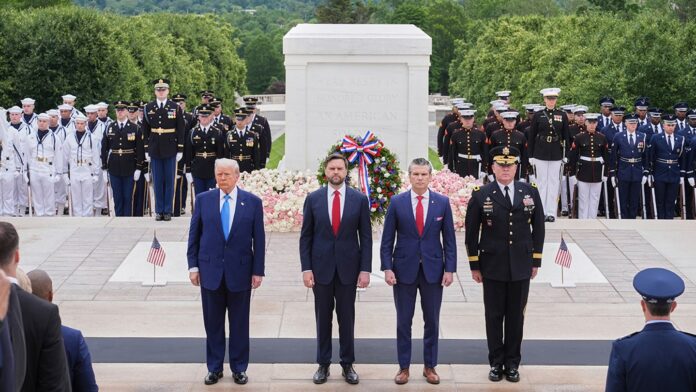Running and winning on a peace through strength ticket, President Trump is the first president to do so since Ronald Reagan. So far, the president has carried out this plan by restoring deterrence and projecting force through the use of the United States’ forward presence in Asia and the Middle East, which includes aircraft carriers, fighters, and bombers, as well as a worldwide network of American military outposts.
The second, more fundamental obstacle to implementing a peace through strength program is the need to resolve serious readiness issues, an overextended army, and an industrial base that is operating at capacity.
On many fronts, the president has achieved his security objectives. The president went after the Houthis to impair their capacity to disrupt international trade passing through the Red Sea, just like he went after ISIS soon after taking office in 2017.
President Joe Biden’s focused pinprick assaults were outdone by war Rough Rider, the biggest air campaign since Trump’s war against ISIS. More than 800 sites were damaged by U.S. airstrikes, which greatly limited the firing of missiles and drones by the Houthis. Following this, the president declared a truce, putting a halt to attacks on ships passing through Middle Eastern waterways by the Houthi rebels.
With a second carrier strike group, a THAAD missile battery, Patriot missile battalions, and B-2 bombers deployed, the president is reinforcing regional deterrence and arming Israel in response to Iran, the principal cause of instability in the Middle East.
The Trump administration has stationed anti-ship cruise missiles in East Asia, a region that many officials are eager to focus on, with a view toward the vital waterways that connect Taiwan and the Philippines. U.S. land-based cruise missiles have never been stationed this close to the Chinese mainland before.
Additionally, Trump has sent two missions to explore the Taiwan Strait for freedom of navigation. On April 23, which is China’s Navy Day, there was a second operation that directly challenged Chinese claims to Taiwan.
Tackle those three primary areas of military stress, and you have the tough part done.
The Navy’s longest surface combat since WWII has been in the Red Sea, and it has done an outstanding job. But a friendly fire incident, multiple drone losses, and two F/A-18s—one lost in an evasive maneuver and another after an unsuccessful arrest—show the constraints of an undersized, overworked, and vulnerable fleet.
Preparation in Asia has also been impacted by operations in the Middle East. Pentagon munitions supplies in the Middle East would run low, forcing redeployments of air defense and potentially drawing on Asian reserves. A deeper problem is shown by the shortage: the current capability in Asia is lost when munitions are transferred, and it will be years before that capability is restored due to the weakness of the industrial base.
Every munition, from 155mm shells to JASSM-ERs, has industrial hurdles. One example is the use of 68% of the 55 Tomahawk missiles purchased by the Pentagon in 2023 in a single day’s fighting the Houthis. The immediate requirement for industrial development is highlighted by the two-year lead time associated with each new Tomahawk.
Although it is commendable, Trump is putting more strain on a force that is already struggling to maintain peace in the Western Hemisphere through military might. The destroyer USS Gravely, which had just finished a nine-month service in the Red Sea, was immediately sent back to help guard the border.
Smart policy decisions, like the organization of U.S. forces in Europe, may alleviate some of the burden. Defense Secretary Pete Hegseth recently directed a massive Army reorganization, which included the replacement of some assault helicopter and tank formations with precise weapons and drone swarms, both of which were effective in the conflict in Ukraine. Next generation warfighting technology is required elsewhere, and Hegseth’s 8% budget reallocation proposal represents a chance to put low-priority budget items into it.
Regrettably, there are indications that techno-optimism could be obstructing responsible budgeting: for FY26, the government sought a basic military budget of $893 billion, far lower than the $1 trillion budget it had pledged, which fails to account for inflation.
Since the United States cashed in on its peace dividend at the conclusion of the Cold War during the Clinton administration, the president’s budget would be the lowest as a proportion of GDP. A declining defense budget would make it difficult for the administration to execute a peace through strength program, since it would not provide enough money to maintain a forward presence, which gives the president military options and bargaining power over enemies.
Thankfully, Trump’s legislative allies are prepared to work with him to implement an ambitious strategy and budget. House reconciliation measure allocates $150 billion to shipbuilding, Golden Dome, and other administration initiatives; committee chairs are resolute in their goal to provide the president’s budget request substantial actual growth.
“Blueprints alone don’t deter aggression,” Reagan said in 1986. Our success in the lab must soon become a victory in the real world. But when our funds are reduced, we are unable to do either.
Standing under massive “Peace through Strength” banners at al-Udeid Air Base, a significant staging ground for the Iraq and Afghanistan conflicts, Trump recently made the proclamation that “America’s military will soon be bigger, better, stronger and more powerful than ever.”
With the correct allocation of funds and a laser-like concentration, he possesses a once-in-a-generation chance to make good on that pledge and establish himself as a president who leads through strength. Beyond using weapons of power, the president can restore that strength and provide a durable peace as he confronts an ascendant axis of Russia, Iran, and China.
